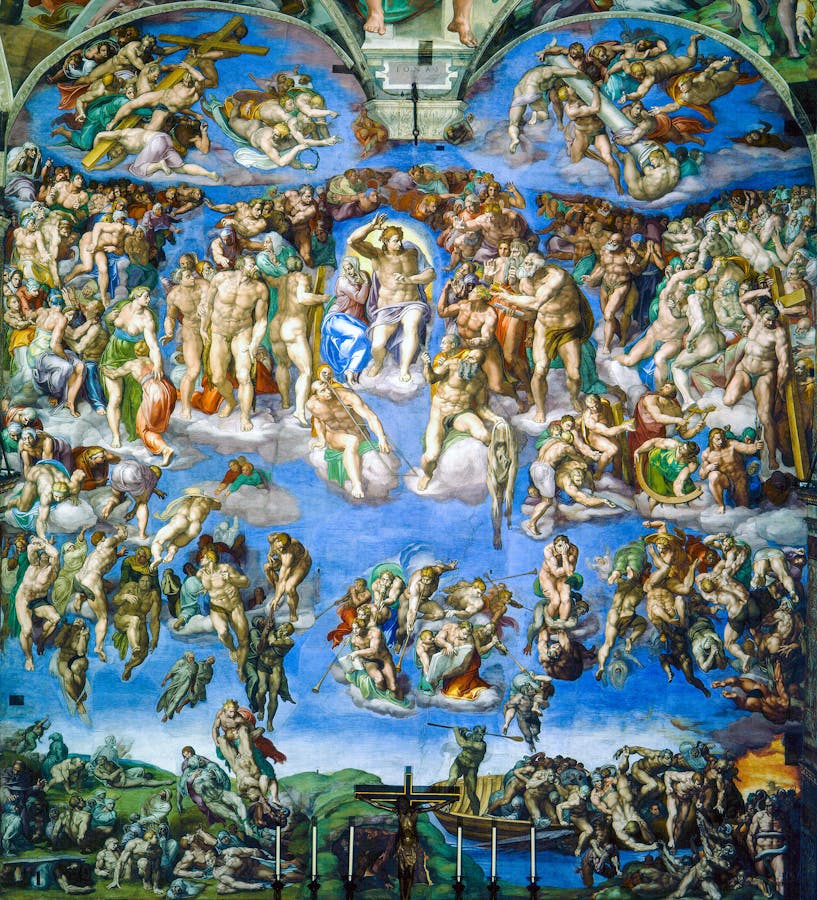In 1947, the Bulletin of the Atomic Scientists introduced the “Doomsday Clock,” a metaphor intended to bring attention to the threat of nuclear destruction. With the hands at 11:53, what could we do before midnight brought about the end?
American artist Martyl Langsdorf created the cover illustration of the “clock.” Her husband had worked on the Manhattan Project, which produced the first atomic bomb in 1945. While it was a remarkable scientific achievement, a growing number of scientists now feared the danger of a nuclear arms race.
Scientists have since updated the Doomsday Clock 27 times to account for other threats to humanity, ranging from artificial intelligence to climate change.

This depiction of the four horsemen of the apocalypse in the Basilica of the Sacred Heart of Jesus in Croatia refers to the stories in the book of Revelation.
Zvonimir Atletić / Alamy Stock Photo

Michelangelo’s The Last Judgement fresco, housed in the Sistine Chapel in Vatican City.
incamerastock / Alamy Stock Photo

Michelangelo’s The Last Judgement fresco, housed in the Sistine Chapel in Vatican City.
incamerastock / Alamy Stock Photo

Michelangelo’s The Last Judgement fresco, housed in the Sistine Chapel in Vatican City.
incamerastock / Alamy Stock Photo

Michelangelo’s The Last Judgement fresco, housed in the Sistine Chapel in Vatican City.
incamerastock / Alamy Stock Photo

Michelangelo’s The Last Judgement fresco, housed in the Sistine Chapel in Vatican City.
incamerastock / Alamy Stock Photo

Michelangelo’s The Last Judgement fresco, housed in the Sistine Chapel in Vatican City.
incamerastock / Alamy Stock Photo

Michelangelo’s The Last Judgement fresco, housed in the Sistine Chapel in Vatican City.
incamerastock / Alamy Stock Photo

Michelangelo’s The Last Judgement fresco, housed in the Sistine Chapel in Vatican City.
incamerastock / Alamy Stock Photo

Michelangelo’s The Last Judgement fresco, housed in the Sistine Chapel in Vatican City.
incamerastock / Alamy Stock Photo
Humans have long wondered about the end of the world. Numerous biblical passages associate the end with God’s judgment of humanity and the establishment of God’s eternal kingdom.
In the New Testament, Jesus warned his disciples that no one knows the day or time of his return.
This hasn’t stopped some people from making bold speculations.
Modern scientists have made their own dire predictions about humanity’s demise, from a new ice age to global famines.
In the 1680s, Puritan minister Cotton Mather predicted the world would end in 1697. He revised his calculations, which he based on his study of the Bible, to pinpoint 1716 and 1736.
In the 1700s, scientist Isaac Newton carefully studied the prophecies of the biblical books of Daniel and Revelation in order to work out a timeline of the end.
In the 1800s, American Baptist preacher William Miller sparked social upheaval by predicting Jesus would return to earth in 1843 or 1844.
In 1967, William and Paul Paddock published the best-selling book, Famine 1975!, arguing that humanity will face mass starvation within a decade. The book was praised by Stanford professor Paul R. Ehrlich, who a year later co-authored the book, The Popular Bomb, which made similar predictions.
In the 1970s, Christian writer Hal Lindsey generated a new wave of interest in biblical prophecies about the future with his best seller, The Late Great Planet Earth, in which he claimed the “rapture” would take place no later than 1981.
In 1974, astrophysicists John Gribbin and Stephen Plagemann published The Jupiter Effect, warning that a planetary alignment in 1982 could cause catastrophic earthquakes. Christian author Hal Lindsey later used this work in his 1970s book.
In the 1970s, University of California, Davis professor Kenneth Watt predicted that global pollution could trigger another ice age by the year 2000. A decade later, scientists were sounding alarm bells about greenhouse gases and the danger of disastrous warming.
In 1982, UN official Mostafa Tolba warned that “by the turn of the century, an environmental catastrophe will witness devastation as complete, as irreversible, as any nuclear holocaust.”
In 2016, University of Arizona biologist Guy McPherson predicted that humans will become extinct in less than a decade due to catastrophic climate change.
“Therefore, stay awake, for you do not know on what day your Lord is coming.”
Matthew 24:42
“Most of the people who are going to die in the greatest cataclysm in the history of man have already been born.”
Paul R. Ehrlich, “Eco-Catastrophe!,” 1969









